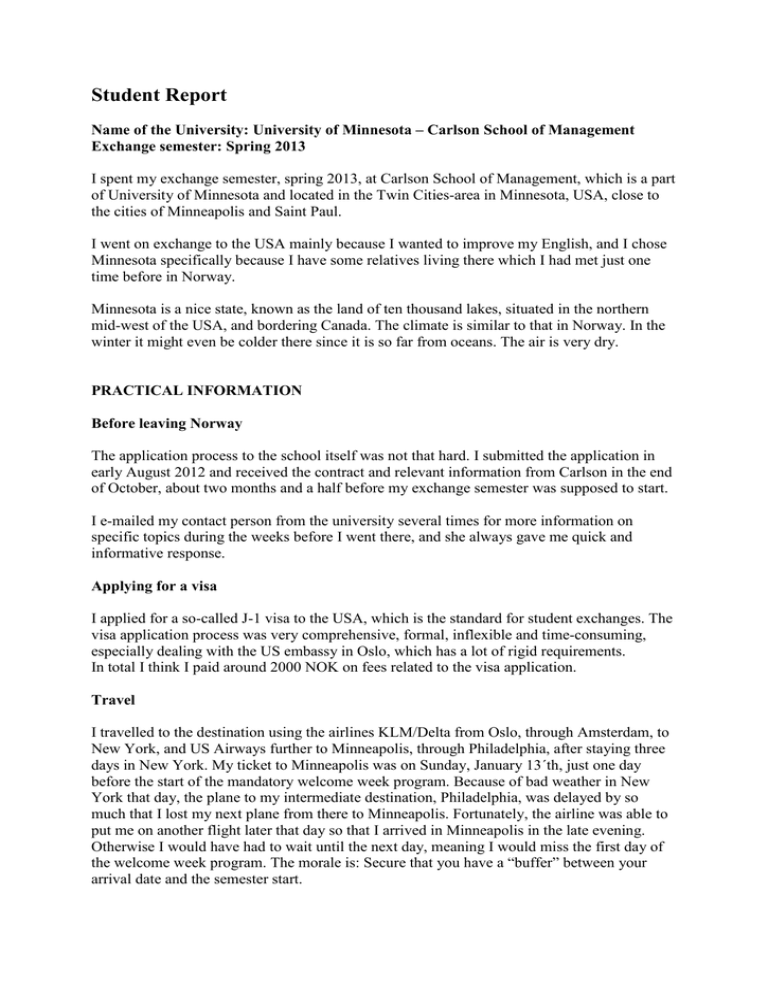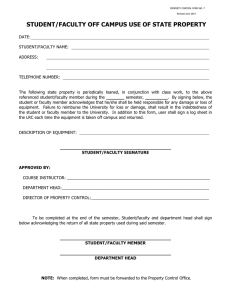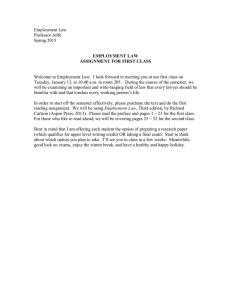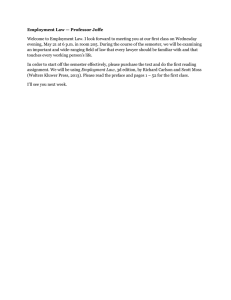Student Report
advertisement

Student Report Name of the University: University of Minnesota – Carlson School of Management Exchange semester: Spring 2013 I spent my exchange semester, spring 2013, at Carlson School of Management, which is a part of University of Minnesota and located in the Twin Cities-area in Minnesota, USA, close to the cities of Minneapolis and Saint Paul. I went on exchange to the USA mainly because I wanted to improve my English, and I chose Minnesota specifically because I have some relatives living there which I had met just one time before in Norway. Minnesota is a nice state, known as the land of ten thousand lakes, situated in the northern mid-west of the USA, and bordering Canada. The climate is similar to that in Norway. In the winter it might even be colder there since it is so far from oceans. The air is very dry. PRACTICAL INFORMATION Before leaving Norway The application process to the school itself was not that hard. I submitted the application in early August 2012 and received the contract and relevant information from Carlson in the end of October, about two months and a half before my exchange semester was supposed to start. I e-mailed my contact person from the university several times for more information on specific topics during the weeks before I went there, and she always gave me quick and informative response. Applying for a visa I applied for a so-called J-1 visa to the USA, which is the standard for student exchanges. The visa application process was very comprehensive, formal, inflexible and time-consuming, especially dealing with the US embassy in Oslo, which has a lot of rigid requirements. In total I think I paid around 2000 NOK on fees related to the visa application. Travel I travelled to the destination using the airlines KLM/Delta from Oslo, through Amsterdam, to New York, and US Airways further to Minneapolis, through Philadelphia, after staying three days in New York. My ticket to Minneapolis was on Sunday, January 13´th, just one day before the start of the mandatory welcome week program. Because of bad weather in New York that day, the plane to my intermediate destination, Philadelphia, was delayed by so much that I lost my next plane from there to Minneapolis. Fortunately, the airline was able to put me on another flight later that day so that I arrived in Minneapolis in the late evening. Otherwise I would have had to wait until the next day, meaning I would miss the first day of the welcome week program. The morale is: Secure that you have a “buffer” between your arrival date and the semester start. Housing During my stay I lived in a dormitory on campus run by the university. When applying for housing I was asked to rank my preferred dorms from a list and also to give my preferences when it came to conditions such as tolerance for noise, tidiness and smoking. I googlesearched the distances between the different dorms and Carlson and found that Middlebrook Hall was the closest alternative. Since distance was my main criteria, I ranked it as my first choice, but ended up being put in another hall. The first week I lived in the other hall, about 25 minutes (and the same number of negative Celsius degrees) walk from Carlson where I had all my classes. All the other students in the exchange group (except one) had got a room in Middlebrook, nicely situated next to Carlson. To save time and pain in the mornings, and to be able to be more social with the other exchange students, I sent an e-mail to a housing coordinator asking to switch hall, and fortunately they had a bed to offer me in a double room in Middlebrook and I could move the upcoming weekend. The moral is: Do not be afraid to ask. Things are often more flexible than you think they are. Costs (for the whole period) Rent Books Food 15 600 NOK 1000 NOK 10 000 NOK Transport Other - NOK - NOK Most books can be rented from the book store Only including the meal plan in the dorm (which also gives you $100 to spend in stores and shops on campus) On campus you can use the Campus Connector for free Depends strongly on what you do The campus area is large and has its own city centre, called “Dinkeytown”, containing amenities as cinema (free by the way), restaurants and clubs. The “Campus Connector” is a bus system which is free for students and takes you all around the campus area. It is therefore no need to go to downtown Minneapolis or Saint Paul, 15 and 30 minutes away from Carlson respectively, that often. Culture and language Most of the trouble I encountered regarding the language came in non-academic situations. Since English is the international business-language anyway, and we use a lot of English literature also at BI, taking courses in English for the most part was fine. On the other hand, with the informal language often spoken among the young American students in the dorm, I sometimes had a hard time keeping up. When it came to cultural experiences, I was surprised how easy Americans are to freak out. In my group´s final presentation in my Buyer Behaviour class, I was supposed to talk about different customer segments for a hair salon chain. I found pictures representing different people on the internet to use as illustrations in the Power Point presentation, including a picture of a young punker flipping of the camera (showing the long finger). My group members were upset by this picture and argued that it was so inappropriate that we could not use it in the presentation. I found it weird. I knew it would never have been an issue back in Norway, but in the end I had to step back and find another picture since the others threatened to boycott the presentation if not. Cultural and social effects from the exchange experience I do not think I have changed that much because of cultural exposure. I am to a certain extent the same regardless of where I am. The main purpose for why I went on exchange was to improve my English, and even if I still do not feel fluid I have inevitably become better. In a global business world this will undoubtedly enhance my career possibilities. ABOUT THE SCHOOL Carlson School of Management is a highly reputable institution in the Mid-West, graduating around 600 undergraduates and 700 graduates each year. It is situated on the west bank of the Mississippi river between the university´s main campus and downtown Minneapolis. Course registration I was given the possibility to register for courses before arrival, but I did not take it because I did not want to spend a lot of time on that while finishing my fall semester at BI. Also, I knew from experience that such things are much easier when you are there and have people around you to assist (which courses can I take? which ones can I not take?) as opposed to struggling with it alone. Even if the exchange coordinators at BI say “It´s so easy, just read the guidelines”, it is always easier when you are there. For example when trying to register on the website, a message tell you “this course is full” or “you do not have the prerequisites to take this course”. When you are there, you just go to the professor and give him your student ID, and he might be able to use a “magic code” on his computer and suddenly you are able to register. The drawback of this strategy is that you might miss the most popular courses since students apply for them early, but for me that was not an issue. I got all the courses I wanted even if I did not register until I came there. And since four of the courses I took there were electives, I would not care that much if I had lost them anyway. If there is a course you are required to take by BI, you might want to choose another approach, though. Academic calendar Arrival date: First day of the semester: Last day of classes: Examination period: Any special events/holidays: January 13´th 2013 January 14´th 2013 May 6´th 2013 May 6´th – May 18´th Spring break: March (18´th-24´th) Arrival The administration was well prepared for my arrival. I got a lot of information ahead of my arrival, even offering me being picked up on the airport. The only bad thing was that the university housing did not open until the academic semester started. Since I had relatives to stay at I was fine, but other exchange students had to stay in hotels during the welcome week. International Office and healthcare The school has an international office dealing with everything that has to do with their incoming exchange students. The university has also a health center on campus where you can go if you need medical aid. Promoting BI and Norway I did not participate in any formal promotions for BI during my stay. I was supposed to participate in an exchange event held in Carlson while I was there, but it collided with a class. An American guy, who had been on exchange to BI, stood at the BI stand instead of me. Social activities During the stay I met and became friends with students from all over the world, including Brazil, Australia, Indonesia, Japan, Poland and Austria. Sadly, I did not learn to know that many native students closely. Those living in the dorm were mostly freshmen coming directly from high school, and thus very young - my roommate was eight years younger than me – and those I took courses with most often had their own lives outside campus. The student organization, Globe, was active throughout the semester, initiating and organizing all kinds of activities for us exchange students, such as ice skating, parties and barbequing. ACADEMICS The study structure in a US university/college is very different from what is normal in Norway. In many ways the experience can be compared to attending upper secondary school in Norway. First of all, the learning environment is much smaller. Classes consist of 20-50, maximum 100, students, and the contact with the professors is much closer and more frequent. Also, the constitution of the grades is different. The final exam usually counts 25-50 % of the total grade, and during the semester you are given homework, quizzes, cases, presentations, participation points and midterms that make up the rest of the grade. In addition, the professors do often take attendance in class. This structure allows no last-week-strategy. An advantage with this structure is that you are forced to even your workload and have a more active approach to the learning process. The drawback is that it takes more effort and time, and gives less flexibility in that you are not able to structure your semester yourself. You might for example have four homeworks due the same day. The structure is also more practically oriented than in Norway, and is more based on lectures than books. In some courses we did not even use the assigned textbook. The university has very good resources available for their students: E.g. breakout-rooms, libraries and computer systems. The U-card is your key to everything on campus. The dorms and dining halls, book stores, breakout rooms, printers, and the Campus Connector bus system. It even works as a payment system in the cafés and convenience stores on campus. Description of courses Course code & name Master/ Bachelor Exam form Prerequisites Approved as Comments FINA 4122 Banking Institutions Bachelor FINA 4621 The Global Economy (Macro) Bachelor MGMT 3010 Intro to Entrepreneurship Bachelor SCO 3001 Intro to Operations Bachelor MKTG 3040 Buyer Behaviour Bachelor Multiple written exams Finance (intro) Elective Multiple written exams Group case Multiple written exams Finance (intro) None Elective Elective Multiple written exams Statistics (intro) Logistics (by BI) Interesting course if you are thinking about a career within finance or banking. NB: This course is a B-term course, meaning its duration is from spring break to semester end. Interesting course which is a good supplement to the macro courses provided by BI. It really focuses on the big picture of the economy. NB: This course is an A-term course, meaning its duration is from semester start to spring break. Thought it would be an interesting course since I like entrepreneurship. Each student has to come up with a business idea and present it to the class. The best ideas are chosen by the class and worked on in groups throughout the semester. The course requires a lot of work, and is not fun if you lose passion for the idea you are working on. This course is approved as a Logistics course by BI. Therefore I had to take it. It is very theoretical and sometimes boring, but luckily it is not that hard. This course is concerned about consumer theory i.e. how people buy? The course requires you to be an active student and is very based upon discussion and class participation. The course also contains a lot of group work. Marketing (intro) Elective




